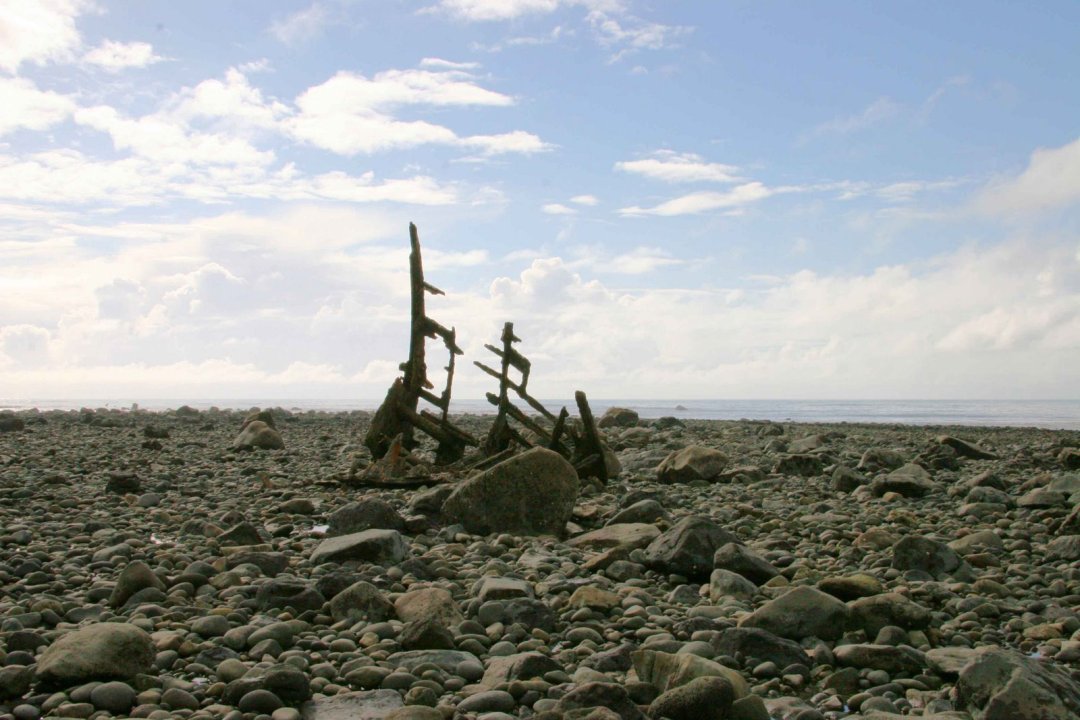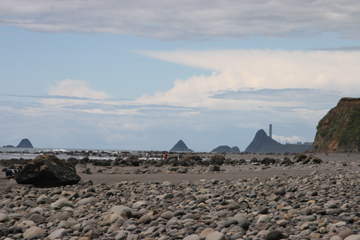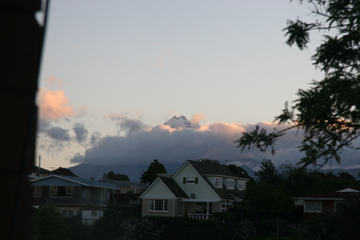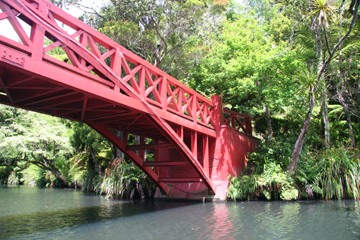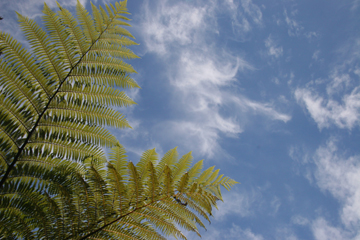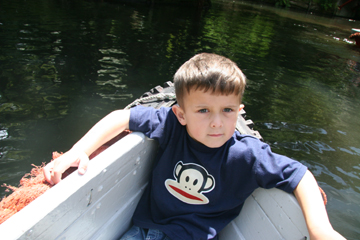It Started With A Kiss..or something like that
Actually it started with an afternoon of drinking strong coffee on the deck in Ponsonby, talking about could-be’s, may-be’s and possibilities for the new year. Stephen has this amazing back deck in the middle of Ponsonby that feels like it’s in the middle of the west-facing Waitakere ranges. So we’re sitting, talking, drinking.. and the subject of Taranaki comes up – that i’ve never been there.. and the next thing you know – i’m headed down a highway I’ve never travelled before, with someone I barely know yet feels like family… and New Plymouth here I come.
We travelled well together but mostly I was lost in the magic of a new landscape.. and thankfully enough my travel buddy was indulgent enough to enjoy the roadtrip with me. It’s been such a long time sense i saw any open road that wasn’t as familiar to me as the back of my hand.
It was such a good time – the trip down, the look on the boys (see above) faces when I arrived to join the rest of the family. The tour around the city, the New Year’s Eve roast & single malt / cigar indulgence as we mellowly saw out 2006. New Year’s Day spent touring the coast, visiting the beach carnival at Oakura and all the small settlements along the way.. and then the road home on Tuesday – finishing with another round of earthmoving coffee on the Pons. deck.
Perfect.
And it started a whole new fresh inspiration and rebirth of taonga for my spirit.
The Journey of Taranaki – as told in Maori legend
In the past many magnificent mountain gods lived near the heart of the North Island Te Ika a Maui (the fish of Maui): Ruapehu, Tongariro, Ngaruahoe, Taranaki, Tauhara… and the only female – little Pihanga.
Pihanga was a gracefully contoured mountain with bush robed flanks and a delicate nature. All the mountains wanted Pihanga for their own – but particularly Tongariro and Taranaki.
The earth shook as the two fought. Lightening crashed, thunder rolled, ash and molten lava spumed from the mountains. In the fighting Tongariro lost his head, some say he deliberately broke it off to fling it at Taranaki, others say Taranaki
sliced it off with a powerful blow. The top flew off and fell into the centre of Lake Taupo where it can be seen today as Moututaiko Island.
But Tongariro was the stronger of the two mountains. He defeated Taranaki, whose peak shuddered and sides convulsed. Tongariro gave a final departing kick to Taranaki’s flanks and the defeated mountain dived underground. Toka – a – Rauhotu, a small stone of great mana acted as a guide stone, leading him to the coast. In his flight he carved the Wanganui River, forming the Ngaere swamp when he stopped to rest.
At the water’s edge Toka – a – Rauhotu lead Taranaki beneath the sea and north-west up the coast. He surfaced briefly and glimpsed Pouakai, a beautiful range. He
settled beside her, and the guide stone rested on his seaward side.
Taranaki and Pouakai had many children, wind and rain, plants and people, rocks and rivers. In the Central North Island Tongariro stands protectively over the little mountain, wrapping her in soft clouds of love as she lies nestled by the town of Turangi on the shores of Lake Taupo.
As children, we travelled far and wide throughout Te Ika a Maui (the North Island). We visited pa sites, sites of the Maori Wars, settlement sites, the first missionary houses, the meetinghouse at Waitangi .. places of huge historical significance. Whatever school didn’t teach us in regards to the Maori culture and the turmoil between Pakeha and Maori.. Mum did. Actually Mum taught us most. We surged around Rotorua, the Auckland Museum and Auckland’s various pa sites all the time.
In 6th form, we studied Parihaka at school for the first time. The land claims tribunal we had studied, as well as the Treaty and all it’s unfortunate translatory misery, the confiscation of land, the purchase agreements on which our major centres were founded.. but in the story of Parihaka I found this enormous juxtaposition of justice, humanity, desire, ancenstry, history, spiritual providence and hope.
Right now the Parihaka festival is being celebrated in the heart of Taranaki – one of the most significant cultural events of the 19th century, that we are only beginning to grasp as part of our nation’s often brutal cultural heritage. This New Year I travelled to Taranaki for the first time in my life, and within me was opened up again the huge sense of wonder and mystery at the history, richness and wonder about the place.
Landmarks
When you’re in a 1982 Mercedes without a radio – you have to absorb the landscape you find yourself in – the road down from Te Kuiti that rolls in and out of valleys, out to the coast and then back in and across the range, through tunnels under Maori burial grounds and back to the coast via rivermouth bridges.
Then heading out of New Plymouth, the coast road that’s flooded with boulders, seacliffs, uncertain sand and wind that pushes you along. The pohutakawas there are flourishing this summer – a brilliant burst of scarlet against bright blue skies. In places where the rolling volcanic domes stop for a moment – you can get a sense of the plateau that reaches out to the edge and then drops off into the sea – the sky seems vast and huge – like it does along America’s long, straight, flat interstates.
The settlements that you stop at are one street, facade-lined tributes to the age of local dairy farming & processing – meatworks, dairy works in every place that made a town, that created a job, and meant a house for a family, with a school and a church and a playground. The further down the coast you roll, the earlier they stopping whirring as technology enabled us to transport further, faster and colder.. the older and more demolished by the salt air they are.
It’s the kind of place that you immediately connect with on some deeper level.. there’s a sense of peace and muddy turmoil undergirding her vitality. There’s an attitude within the people that you meet that is 2 parts ‘screw-you’ and 2 parts ‘good on ya’. It’s an inescapable strength and yet the place is filled with gang history, violence and volatility.
Perhaps it’s the moodiness of the long love-lorn Taranaki, pining for his love. Perhaps the desire of Taranaki people to prove themselves stems out of his lost battle to win Pihanga’s affection. No Maori live in the line between Taranaki & Tongariro, where Pihanga rests, as they believe that one day the mountain will return to claim her. Perhaps it’s the bloodiness of the land, and the Maori history of inter-tribal battles that pushed the Taranaki tribes to the coast from the inland Tainui tribe of the Waikato. It could even be the remnant of resistance to the Treaty of Waitangi .. that the Taranaki tribes never signed, that fuels the independence and spirit of the place.

The Legacy of Parihaka – A Tale For Our Time
This history of Parihaka tells the story with much factual detail. Let me overview for you briefly from my 6th form memory..
During the land confiscations and dispossesion of the Maori people from their lands all over New Zealand, the Parihaka settlement was established. It became home to so many who had been removed from their tribal lands by the Crown, lands that were confiscated and yet not occupied in many cases. In 1881, the Crown invaded Parihaka which then led to a series of passive acts of resistance. Led by the prophets Te Whiti and Tohu Kakahi (men of both Christian and Maori belief), the lands were ploughed, fences erected, and on and on and on.
The white feather that Te Whiti and his followers wore was an ongoing symbol of their commitment to the belief that New Zealand could successfully be bi-cultural, so long as certain respects for Maori land ownership and cultures were respected by the Crown.
So much of the spirit of that struggle lives on .. Driving down Highway 45, you see pa site after pa site – the lands of Taranaki that were once occupied and productive, the site of so many battles through the Maori (or better called the New Zealand) Wars of the 1800’s.
The white man’s thirst fo
r land that he couldn’t use or populate is remarkable. The inherrant arrogance of superiority. The slide that appropriation and justice by any definition quickly takes into bloodshed and pointless aggression.
So in those days, and in these days .. where is the God who commanded Israel to take possession of the land? What does he say to the Gentile today? What does he say to the displaced children of Israel? What did he say then to the displaced children of Maori?
Humanity tells it’s tales over and over and over again, like fables to a child.. what is the place of peace in a time like this?
